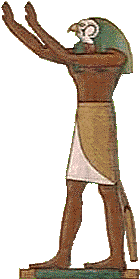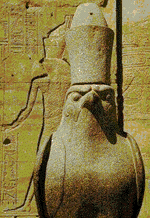Horus
| |
Egyptology Articles
Herbs and Aroma
Alternative
Medicine
Aroma Therapy
|
Horus is one of the important Gods of the ancient Egyptians. He is represented as a falcon-headed god. The ancient Egyptians worshipped a lot of different Gods. However Horus is very powerful and important as he is represented by many forms all meaning kinship and power.
Horus famous story is derived from being the son of Osiris and Isis, the son who avenged his father's death by the hands
of his uncle Seth and thus became , the son God, the ruler and the law. The son of Osiris and Isis, Horus became the ruler of Egypt after Osiris' death. In order to win the throne, Horus had to do battle against his uncle, the god Seth.
Seth was defeated and was relegated to the role of ruler of the chaotic desert lands surrounding Egypt. As a divine ruler, Horus had associations with the living pharaoh. Sometimes depicted as a falcon or a man with a falcon head, Horus was also seen as a sun sky. As the child of Isis, Horus was also worshipped in the form of Harpocrates (Horus-the-child) and is often shown as a child nursing at the breast of Isis. In the Late Period images of Horus the child were placed on small plaques called "cippi," which were used to ward off evil and provide cures from illnesses and snake
bites.
This God has several names and several forms with different
faces. He is the divine personification of the kingship and the god of the heavens at the same time.
The name Horus comes from the Egyptian word Hor, which translates as 'face'. We find him worshipped as Mekhenti-irry which translates as 'He who has on his brow Two Eyes', the sun and moon representing his eyes. On nights when there is no moon we find him worshipped as Mekhenti-en-irty, 'He who on his brow has no eyes', in this form he was considered the god of the blind.
|
 |
The followers of Horus invaded Egypt in pre dynastic history, at this time he was venerated as a victorious warlord. He became a part of the state religion and was associated with the sun god, Ra. Horus was so important to the state religion that Pharaohs were considered his human manifestation and even took on the name Horus.
Other Names:
Haroeris (Horus the Elder) An early form of Horus. He was a god of light. His eyes represented the sun and the moon. He was also the brother of Osiris and Seth. Sometimes he was the son, or the husband of Hathor.
Horus Behudety In the form of Horus of Edfu, he represented the midday sun. This Horus was worshipped in the western Delta and later, as his cult spread south into Upper Egypt, a cult center was established in Edfu. Horus of Edfu fights a great battle against Seth and an army of conspirators. He is pictured as a winged sun-disk or as a hawk headed lion.
Ra-Harakhte (Horus of the two horizons) This horus was identified with Ra and the daily voyage of the sun from horizon to horizon. The two deities combined to become Ra-Harakhte. He was represented as a falcon or a falcon-headed man wearing the solar disk and double crown or the uraeus and the atef crown.
Harmakhet (Horus in the Horizon) In this form he represented the rising sun and was associated with Khepri. He was also considered to be the keeper of wisdom. He was sometimes pictured as a man with a falcon's head, or a falcon headed lion. But his most recognizable form is that of a sphinx, or as a ram-headed sphinx.
Harsiesis (Horus son of Isis) This Horus was the son of Isis and Osiris. He was conceived magically after the death of Osiris and brought up by Isis on a floating island in the marshes of Buto. The child was weak and in constant danger from the scheming of his wicked uncle Seth, who sent serpents and monsters to attack him. But his mother, Isis was great in the magical arts and she warded off this evil by using a spell against creatures biting with their mouths and stinging with their tails, and the young Horus survived and grew.
Harpokrates (The infant Horus) As a child he represented the new born sun and was often pictured being suckled by Isis. he was usually represented as a seated child, sucking his thumb, his head was shaved except for the sidelock of youth. Even as a child, he wore the royal crown and
uraeus.
Harendotes (Horus the avenger of his father).
Har-pa-Neb-Taui (Horus Lord of the Two Lands).
Heru, Hor, Harendotes/Har-nedj-itef (Horus the Avenger), Har-Pa-Neb-Taui (Horus Lord of the Two Lands).
Patron of: the living Pharaoh, rulers, law, war, young men, light, the sun, many others depending on the particular variant.
Appearance: His most common form is that of falcon-headed man, but he is also shown as a falcon, a lion with the head of a falcon, or a sphinx. He is also shown as a falcon resting on the neck of the pharaoh, spreading his wings to either side of the pharaoh's head and whispering guidance in his ear.
Description: It is nearly impossible to distinguish a "true" Horus from all his many forms. In fact, Horus is mostly a general term for a great number of falcon gods, some of which were worshipped all over Egypt, others simply had local cults. Yet in all of his forms he is regarded as the prince of the gods and the specific patron of the living ruler.
|
As the living king was a
Horus, when he died, his successor became the new living image of Horus
and the dead king became Osiris, Horus' father. The cyclic renewal of
the creation was thus ensured by the constantly renewing monarchy. As
the heir of Osiris, Horus also represents all that is just and right.
After Osiris was murdered by his brother Seth, his heritage was claimed
by Seth, who tried to cast aside Osiris' legal heir. With the help of
his mother Isis, Horus demands justice and attacks his uncle. When Horus
emerges victoriously from his battles with Seth, Osiris' heritage is
given to him, ending the chaos and uncertainty of Seth's rule. Because
of his battles against injustice, Horus is also seen as a protector-god,
a god who attacks and destroys evil where- and whenever he can.
As the god of the heavens, he is often
represented as a falcon or as a man with the head of a falcon. As such,
he is the protector of the heaven and of the sun god Re.
|
 |
|
Two times
Horus at his temple in Edfu. On the foreground as a falcon, wearing the
double crown and in the background as a falcon-headed man wearing the same
crown. |
The worship of Horus was brought from the outside by neighboring tribes who invaded and then settled into Egypt. He was their god of war, but was quickly absorbed into the state religion, first as a son of Ra, then changing to become the son of Osiris. He was the protector and guide to the pharaoh and later pharaohs were believed to be his avatar on earth. Horus was also the patron of young men and the ideal of the dutiful son who grows up to become a just man.
The most popular story of Horus is the one in which he grows to manhood to avenge the death of his father Osiris by battling against his cruel uncle Set. In many writings, he is said to continue to battle Set daily to ensure the safety of the world.
Worship: Worshipped widely throughout all of Egypt, even his variant forms were widespread.
Birth & Flight of
Horus:
Then there is the myth sometimes called the Birth and Flight of Horus. This tale, found in the Coffin Texts, is a combination of two stories. The first is the birth of Horus, and the second is a very old and fragmented myth that the sun burst out of an egg laid by a primeval being or goose floating on the primordial waters before creation. The Birth and Flight of Horus begins just after Osiris's death. The tone is much more serious than that of the Delta Cycle or the Great Quarrel. The world was being terrorized by Set. Isis dreamed that she would have a son who would avenge her husband's death and asked Atum if this son would be allowed a seat on the sun boat. However, just before the birth, Isis realized that she would be giving birth to a Falcon, not a child. Upon the birth, Atum saluted Horus and told him that he would give him his name after Horus flew to the horizon. While the company was discussing other matters, such as Horus's seat on the boat, Horus flew up on his own, higher than even the "old" gods who inhabited the constellations. Horus proclaimed to the gods below that he would, indeed, avenge his father's death. This myth, as mentioned before, combines two others together. According to some sources, there were actually two gods named Horus. The first, the original Falcon, flew up at the beginning of time upon his birth. The second, son of Isis, was forced to grow up in secret for fear of Set, as described in the Delta Cycle myth. The myth of the Birth and Flight of Horus brings these two gods into one.
|
You may freely reprint this article
or place it on your website by
adding this statement: Courtesy of www.kingtutshop.com
|
_________________________________

